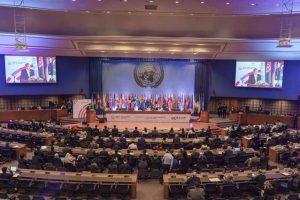Oxford Professor Receives Abel Prize For Solving 300-Year-Old Mathematical Mystery
It was a problem that had baffled mathematicians for centuries — until British professor Andrew Wiles set his mind to it.
“There are no whole number solutions to the equation xn+ yn = zn when n is greater than 2.”
Otherwise known as “Fermat’s Last Theorem,” this equation was first posed by French mathematician Pierre de Fermat in 1637, and had stumped the world’s brightest minds for more than 300 years.
Andrew Wiles, research professor of Mathematics at Oxford, has been awarded the top prize in the field “for his stunning proof of Fermat’s Last Theorem by way of the modularity conjecture for semistable elliptic curves, opening a new era in number theory”.
Decades later, the now Sir Andrew Wiles – a professor of mathematics at the University of Oxford in the UK – has been awarded the prestigious Abel Prize for 2016, likened to the Nobel Prize of the math world. The award, bestowed by the Norwegian Academy of Science and Letters, carries with it a cash prize worth more than US$700,000, which some might say isn’t such an extravagant reward for a proof described as “an epochal moment for mathematics”.
“It is a tremendous honor to receive the Abel Prize and to join the previous laureates who have made such outstanding contributions to the field,” said Wiles. “Fermat’s equation was my passion from an early age, and solving it gave me an overwhelming sense of fulfilment.”
“It has always been my hope that my solution of this age-old problem would inspire many young people to take up mathematics and to work on the many challenges of this beautiful and fascinating subject.”
The Oxford professor said solving the theorem gave him an overwhelming sense of fulfilment.
When Wiles was 10 years old, he had stumbled upon Fermat’s Last Theorem in E.T. Bell’s “The Last Problem” at his local library in Cambridge.
The theorem was formulated by Pierre de Fermat, a French mathematician, in 1637. It states that there are no whole number solutions to the equation x^n + y^n = z^n, when n is greater than 2.
Wiles said the problem captivated him as a young boy. The theorem has been the most popular problem in mathematics, but he didn’t know it at that time.
“What amazed me was that there were some unsolved problems that someone who was 10 years old could understand and even try. And I tried it throughout my teenage years,” Wiles told The Guardian. “When I first went to college I thought I had a proof, but it turned out to be wrong.”
A Story Of Resilience And Tenacity
While he was a faculty at Princeton University, Wiles decided to embark on a solitary quest to solve the problem.
After seven years of intense studying, Wiles disclosed his proof to the public in a series of lectures at Cambridge in 1993. When the professor wrote the proof on the board to end his lectures, the room had erupted in applause.
Unfortunately, a mathematician found error in his proof in 1994. He was devastated, but vowed to fix the error.
Wiles called on his former student Richard Taylor to help him. After a year, the error was corrected and the revised proof was published.
How did Wiles solve the problem? He combined three complex mathematical fields: elliptic curves, modular forms and Galois representations.
“The truth is the methods I used were not any more sophisticated than I could certainly do as an undergraduate,” said Wiles.
But the pressure on the shy mathematician almost crippled him.
“It was very, very intense,” said Wiles. “Unfortunately as human beings we succeed by trial and error. It’s the people who overcome the setbacks who succeed.”
Wiles’ methods to solve the theorem have had a lasting effect on the field of mathematics, and are still being used today. He actually took a different approach to solve the problem – by proving the 1950s Shimura-Taniyama conjecture, which proposes that two very different branches of mathematics are conceptually equivalent.
The professor said the proof didn’t just solve the problem, it also introduced new ways of attacking Langland’s Program – one of the big webs of conjectures of contemporary mathematics. This aims to unify different branches of the discipline.
Meanwhile, although it had been difficult for Wiles to get back into work, he is working on another major unsolved conjecture in history – the Birch and Swinnerton-Dyer Conjecture.
“The beauty of mathematics lures you back in,” added Wiles. “It has always been my hope that my solution of this age-old problem would inspire many young people to take up mathematics and to work on the many challenges of this beautiful and fascinating subject.”




